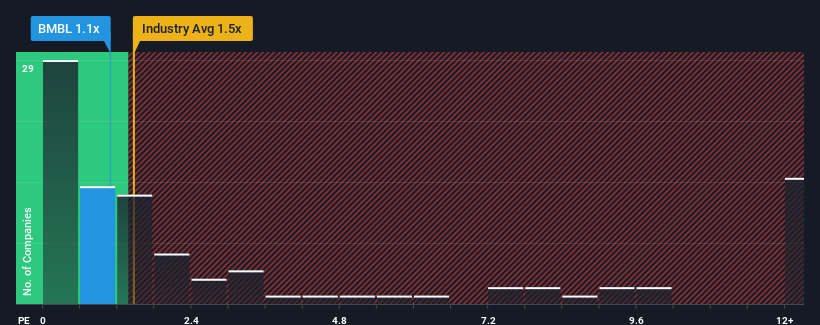- United States
- /
- Interactive Media and Services
- /
- NasdaqGS:BMBL
Bumble Inc.'s (NASDAQ:BMBL) Business Is Trailing The Industry But Its Shares Aren't
With a median price-to-sales (or "P/S") ratio of close to 1.5x in the Interactive Media and Services industry in the United States, you could be forgiven for feeling indifferent about Bumble Inc.'s (NASDAQ:BMBL) P/S ratio of 1.1x. However, investors might be overlooking a clear opportunity or potential setback if there is no rational basis for the P/S.
View our latest analysis for Bumble

How Bumble Has Been Performing
There hasn't been much to differentiate Bumble's and the industry's revenue growth lately. The P/S ratio is probably moderate because investors think this modest revenue performance will continue. If this is the case, then at least existing shareholders won't be losing sleep over the current share price.
Keen to find out how analysts think Bumble's future stacks up against the industry? In that case, our free report is a great place to start.Is There Some Revenue Growth Forecasted For Bumble?
The only time you'd be comfortable seeing a P/S like Bumble's is when the company's growth is tracking the industry closely.
Taking a look back first, we see that the company managed to grow revenues by a handy 15% last year. This was backed up an excellent period prior to see revenue up by 70% in total over the last three years. Therefore, it's fair to say the revenue growth recently has been superb for the company.
Shifting to the future, estimates from the analysts covering the company suggest revenue should grow by 9.4% each year over the next three years. With the industry predicted to deliver 12% growth each year, the company is positioned for a weaker revenue result.
With this in mind, we find it intriguing that Bumble's P/S is closely matching its industry peers. Apparently many investors in the company are less bearish than analysts indicate and aren't willing to let go of their stock right now. Maintaining these prices will be difficult to achieve as this level of revenue growth is likely to weigh down the shares eventually.
What Does Bumble's P/S Mean For Investors?
Typically, we'd caution against reading too much into price-to-sales ratios when settling on investment decisions, though it can reveal plenty about what other market participants think about the company.
When you consider that Bumble's revenue growth estimates are fairly muted compared to the broader industry, it's easy to see why we consider it unexpected to be trading at its current P/S ratio. At present, we aren't confident in the P/S as the predicted future revenues aren't likely to support a more positive sentiment for long. This places shareholders' investments at risk and potential investors in danger of paying an unnecessary premium.
Before you settle on your opinion, we've discovered 1 warning sign for Bumble that you should be aware of.
Of course, profitable companies with a history of great earnings growth are generally safer bets. So you may wish to see this free collection of other companies that have reasonable P/E ratios and have grown earnings strongly.
Valuation is complex, but we're here to simplify it.
Discover if Bumble might be undervalued or overvalued with our detailed analysis, featuring fair value estimates, potential risks, dividends, insider trades, and its financial condition.
Access Free AnalysisHave feedback on this article? Concerned about the content? Get in touch with us directly. Alternatively, email editorial-team (at) simplywallst.com.
This article by Simply Wall St is general in nature. We provide commentary based on historical data and analyst forecasts only using an unbiased methodology and our articles are not intended to be financial advice. It does not constitute a recommendation to buy or sell any stock, and does not take account of your objectives, or your financial situation. We aim to bring you long-term focused analysis driven by fundamental data. Note that our analysis may not factor in the latest price-sensitive company announcements or qualitative material. Simply Wall St has no position in any stocks mentioned.
Have feedback on this article? Concerned about the content? Get in touch with us directly. Alternatively, email editorial-team@simplywallst.com
About NasdaqGS:BMBL
Bumble
Provides online dating and social networking applications in North America, Europe, internationally.
Undervalued with adequate balance sheet.
Similar Companies
Market Insights
Community Narratives



